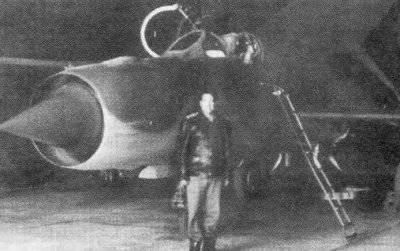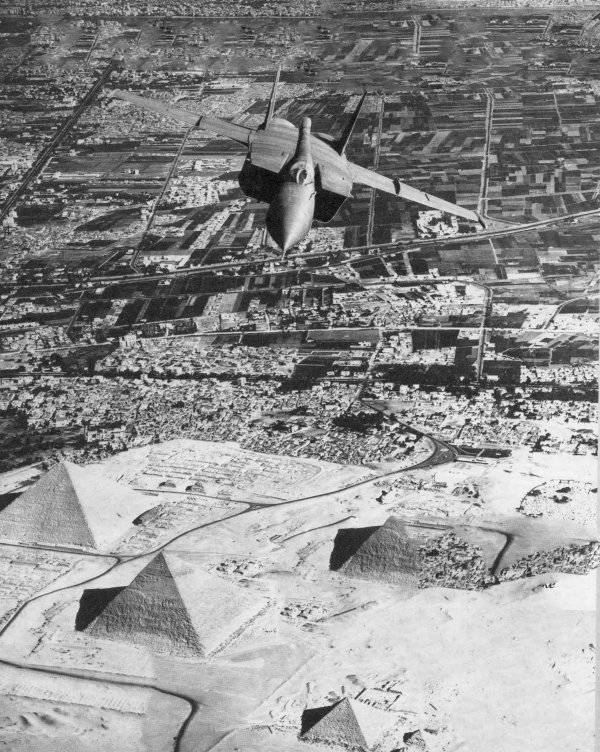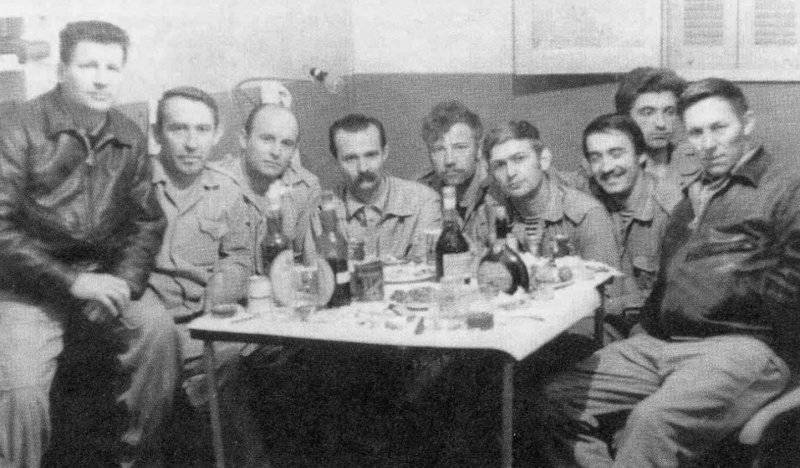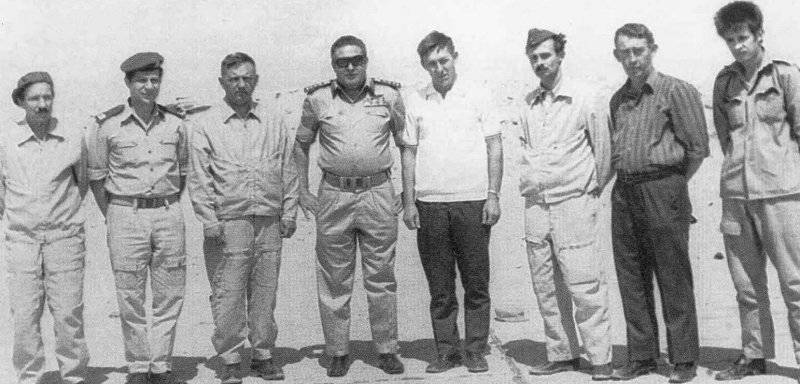Go to the land of Egypt
“Go to the land of Egypt and see how many troops there are and what is its strength”, this biblical message could be a flight mission for the Mig-25 pilots. In 1971-1972 they conducted intelligence in the Middle East over the Suez Canal, the Sinai Peninsula and the coastline of Israel. In the October days of 1973, fast-moving two-wheelers reappeared over Sinai.
6 October 1973, another Arab-Israeli war broke out. The Arab states were trying to take revenge for past failures, to return the occupied lands and make a break in the situation in the Middle East. However, on the sixth day of the war, the changeable military happiness began to turn away from the Arabs.
To gain the unlucky Arab ally in the USSR, they began to prepare the air group on the basis of the best units and instructors of the Air Force flight training centers. The commander of the group was appointed Major General MS Dvornikova, whose headquarters were deployed in the Soviet embassy in Cairo.
The Egyptians should have been supported by the intelligence officers of the 47 separate guards reconnaissance aviation regiment (ORAP) based in Shatalovo near Smolensk. Formed as a separate squadron in the fall of 1941 in Monino, the regiment with honor went through the whole war, was marked by awards, including the “commander-in-chief” order of Kutuzov, and had a rich history. By the beginning of the 70's he was stationed in the Moscow Military District and was considered the leader. In 1971, the first in the Air Force received reconnaissance MiG-25. The top leaders of the Defense Ministry and the Air Force, the creators and testers of the new machine, were frequent guests at Shatalovo.
On the basis of the 47 th ORAP, military tests of the “twenty-fifth” were conducted, work to expand its flight and combat capabilities, including the development of bomber weapons. The scout-bomber MiG-25РБ became the first Soviet aircraft capable of destroying ground targets from high supersonic speeds (up to M = 2,4) and heights more than 20 km. The flight and bombing were carried out in automatic mode using the Romb-1 K radio navigation system and the autonomous inertial Peleng-D, which ensured accurate wiring of the aircraft to the target, the coordinates of which were “stitched” into the computer memory during the pre-flight preparation. The system independently solved the sighting task, taking into account the speed and altitude of the flight, the wind speed, the angle of demolition, and dropped bombs at the design point. On multi-frame girder holders under the wing and fuselage, the aircraft could carry up to 8 heat-resistant high-explosive bombs FAB-500T and TM, specially designed for MiG-25РБ and having a body insulation and aerodynamically heated fuse. When the FAB-500 fell, it developed a tremendous speed, even when it was out, with which it hit the surface of the earth. During the triggering time of the fuse, the bomb pierced the ground, like oil, had time to go forward on 30 - 40 m and left two craters - in the places of fall and explosion.
The suspension was provided for MiG-25РБ and “special items” - nuclear weapons, with simulators of which the pilots performed many sorties at the test site in Belarus near Luninets, mastering supersonic bombing. With a speed of M = 2,35 and an altitude of 22 000, the bomb, like a tactical rocket, flew to the target to 40 km, and the plane after its separation could turn away from the combat course without entering the air defense zone. For the alleged objects of attack - large area targets such as industrial enterprises, railway stations, ports and warehouses - the accuracy of hitting about a hundred meters was sufficient.
Attack capabilities of the MiG-25RB could now be claimed. The situation on the Egyptian and Syrian fronts for the Arabs changed for the worse with each passing day, and the raid on Tel Aviv, which could change the situation all at once, was considered seriously.
At the pre-dawn hour of 11 on October 1973, the 47 of the ORAP was alarmed. The pilots and technicians on helicopters were transferred to the operational airfield, where their planes were located, having set the task: the regiment to be ready, and from the most experienced pilots to form a detachment to perform the task in isolation from the base for a long time. The reason for the collection was also clarified: the aviators had to relocate to Egypt and, as the order said: "... to ensure readiness for the bombing attacks."
Shortly before this, the Israeli air defense was able to cope with the cruise missiles launched from the Egyptian Tu-16, but no one could have shot down the bombs flying from the stratosphere. The Twenty-fifth was the only machine in the world capable of attacking the capital of Israel without hindrance - there was nothing for the enemy to repel the impact of the super-fast high-altitude MiG. About a hundred of the Hawk air defense system, covering large cities, airfields and Israeli enterprises, had a reach of no more than 12 200 m and a slant range to 31 km. The MiG-25RB was noticeably superior to both Israeli air defense fighters — the Phantoms and the Mirage were inferior to him in altitude and speed. The pilots of the 47 of the ORAP knew this firsthand - the regiment personnel already had experience in the Middle East in 1971 - 1972.
For all the fees, the group that received the name of the 154 th separate air detachment (JSC) was given two days. At that time, one of the squadrons was leaving to strengthen the other “front line” - the 4 air army in Poland, which was opposed to NATO, and in the 47 regiment only 10 MiG-25РБ remained. For the transfer to Egypt prepared 4 of them. The squadron sent 220 people: 7 pilots (half of all who had mastered the MiG-25РБ) - the regiment commander, Lieutenant Colonel N. Chudin, who led the group, Major V. Mashtakov, captains Y. Garmash and S. Bukhtiyarov, senior lieutenants V. Golovanov, A Severin and S. Small; technical personnel ("Krylov's people" - a regiment engineer for aircraft and engine); management and communications officers. An instructor from the Voronezh Flight Training Center, Major V.Uvarov, who flew first MiG-25 and, like Mashtakov, who already went on reconnaissance flights over Sinai, was seconded to the squadron, specialists from the Mikoyanovsky Design Bureau, Gorky Aviation Plant and the MAP.
The status of the pilots and technicians flying to a belligerent country was “forgotten,” as it were. Cairo announced the end of the stay of the Soviet military and their departure in July 1972, and according to the existing international treaties, foreign advisers and specialists with the official start of hostilities had to leave the country immediately. In addition, they were not supposed to have weapons... Therefore, the existence of a detachment of the top secret and all 220 sent to Egypt became stateless people. They took away not only documents, but even watches and matches with the mark “Made in the USSR”, and on the spot they dressed them in Egyptian field uniforms without any insignia. Whom one should nevertheless impersonate himself on occasion — they did not give instructions. Stars and numbers were painted over the airplanes, but they didn’t put identification marks on ARE - no one would believe anyway!
Each MiG-25RB was rolled up and moored in “its own” An-22, placing a number of special transport cradles with undocked wings, keels and stabilizers. The first flights sent bombs and gunsmiths. Total for the relocation of the detachment took 12 flights An-22 and 72 - An-12. "Trump card" - 154-th OAO in a hurry to put into action. His transfer, along with the delivery of anti-aircraft missiles and fighters to the Arabs instead of those that had been knocked out, became a priority for the VTA. The air bridge lay over the Mediterranean Sea, where the Soviet ships along the route served as landmarks and radio beacons. They were supposed to protect the track from the attack of Israeli fighters with their air defense missile systems. The first flights to Egypt were transported by 13 on October, and the very next day, 154 was unloaded at the Cairo-West air base.
He met a detachment of General Dvornikov, who immediately set the task: to prepare aircraft for reconnaissance over the front line. In the war came a turning point, the Egyptians were in a hurry to fix the position of the troops from the air, confirming the conquered territories, which could be used in armistice negotiations, by taking pictures. The planes immediately rolled into underground caponiers, after all, there were battles only a hundred and fifty kilometers away. On that day, before 70 Israeli aircraft tried to break through the Nile Delta to the Arab air bases. Specially built at the time for the "twenty-fifths" shelter reliably defended scouts. Similar structures were not even at home. The “cellars” equipped with thick arches of reinforced concrete equipped with a three-meter layer of earth were connected to the fuel lines, communications and electricity, space was provided for people and storage rooms, and ventilation worked. Underground, they assembled and debugged cars, transferred the brought property to the same place; True, the rush made itself felt - for a long time I had to look for the necessary equipment and tools in the drawers scattered in all corners, remembering the saying about two moves, equal to one fire.
However, the scouts were vulnerable on takeoff and return, when the heavy MiG did not have speed and maneuverability. By the very Cairo-West, tightly covered SAM and anti-aircraft artillery, enemy attack aircraft did not try to break through, but more than once appeared near. One day, air alarms were announced 26 times, and an attempt to intercept MiGs at an airfield was quite possible. There was no reason to expect reliable cover from the Egyptians - they fought fierce air battles over the canal, losing on a different day on 10 - 15 fighters. To reduce the time spent by the scout at the airfield's concrete site - the “twenty-fifth” was too appealing — they developed a take-off scheme baptized by a “little devil from a casket”. Starting and testing of engines was carried out in caponiers, then before the plane ready for departure, the gate was opened, he was taxiing to the nearest three of the runways Cairo-West and immediately started. Takeoff was carried out in a southerly direction in order to reach the beginning of the route along the shortest path.
We decided to go reconnaissance right after the assembly and reconfiguration of the onboard equipment without conducting a test flight and training sessions. It was a violation of the established order. However, the task was urgent - they indicated not only the day, but also the time of the shooting, and it was even more risky to meet with interceptors once again. For reliability, the reconnaissance route was carried out by a couple, duplicating the survey in case of equipment failure at one of them or failure.
October 18 in the first flight went Vladimir Uvarov and Alexander Severin. They had to take the cars along the route practically on their hands, because navigation beacons at the airport did not have time to deploy. The aircraft took off at a 15-second interval and headed towards the southern tip of the Suez Canal.
Turning to the north, over the Port Taufik the pair entered the combat course. From the height, the entire 160-km route opened up — the endless beach of the dazzling sands of Sinai with rare specks of oases. It took place at full afterburner, maintaining the speed of M = 2,5.
The raid of Uvarov and Severin was successful, and the pyramids again opened in front of them through 35 mines - a sure landmark of the proximity of the airfield. Without lingering on the usual "box", the scouts sat down on the move and immediately went to the shelters.
On the same night, cassettes with film tape and radio reconnaissance records attached to the An-12 search and rescue unit and communications were taken to Moscow. Dozens of meters of wide-format photographs, dotted with notes and symbols, captured the situation at the front: Egyptian sappers crossing the canal, defeated and continuing to hold Israeli defense units, a deeply layered second line of fortifications in the foothills and a lot of black “commas” - a burn from hundreds of tanks and armored vehicles.
However, these days, it was more likely to conduct reconnaissance along the western bank of the canal. On the eve, the Israelis managed to find the vulnerable spot of the Egyptian grouping and, striking the flank of its 2 Army, reach the coast near the town of Hamsa. The channel here passed through Big Bitter Lake, reaching 10 - 12 km wide. The Egyptian command neglected defensive positions on its shore, considering retaliation in such an inconvenient place unlikely, and the Israeli landing force freely crossed the lake. A group of 15 armored personnel carriers and PT-76 captured tanks succeeded in what the Israeli headquarters didn’t dream of, who were planning, at best, to keep the defense at Sinai. Two days later, the captured bridgehead was expanded to 200 km, and 5 armored and mechanized brigades focused on it deep into Egyptian territory concentrated on it. On October 21, the enemy reached the railroad and highway, being a hundred kilometers from Cairo - at a distance of one tank throw.
In a tense situation in the 154-m, OAO took special precautions. In the event of the appearance of enemy commandos, the airmen did not part with pistols and machine guns (there was already a case when Israeli saboteurs landed deep in the rear managed to cut out the security of the newest P-35 radar and take out the 3,5-ton station to their helicopters). In the caponier there were suspended five-toned tanks, with which MiG-25RB could fly to the nearest Soviet airfield of Vaziani in Georgia under the threat of a base seizure (the shortest course of course led over the territory of Turkey). In extreme cases, the shelters themselves were mined, so that they could be blown up, burying MiGs under blocks of concrete, and an additional demolition expert hung each of the secret planes with a net of 120 net checkers for the night.
Actions 154-th OAO continued. Training flights for the purpose of restoring flight skills for security were conducted at home, sending a group of pilots to the An-12 for a couple of days to the Union. A total of scouts made 4 combat sorties. Each of them wore a “piece” character and ranked as particularly important, because for one MiG-25РБ raid, the tactical situation along the entire 160-km of the front line was opened. The main “weapon” of the scout was the panoramic aerial cameras (AFA) A-72 installed on the swinging platforms in the air-conditioned photo-compartment - impressive devices with a focal length 1100 mm. In a single pass, they performed a four-band survey, capturing 90 - 120 km to the sides, depending on the height of the flight. The AFA A-70M, with a slightly lower resolution, filmed an even wider band, and the planned fixed E-70 conducted general reconnaissance and fixed the area below, providing binding to the highway. At the same time, radio reconnaissance was carried out by the Virage station, which revealed the position of the radar and anti-aircraft positions. Tactical reconnaissance "on the regional scale" engaged in the MiG-21Р Egyptian air wing. The full arrival of our air group did not take place, and four MiG-25РБ were the only Soviet aircraft in Egypt. Along with them, with the 13 of October in the Middle East, began to conduct regular air reconnaissance from bases in Europe, the American SR-71. About their activities and to this day little is known. The work of the MiG-25P was not a secret for the enemy - Israeli newspapers wrote about the scouts nicknamed "Alpha", and this name even got accustomed in the detachment itself.
When planning their flights, the Soviet aviators encountered a peculiarity: precisely at the appointed time of departure, Israeli fighters appeared over the canal, patrolling in anticipation of production. It remained to go to the trick: to declare the Egyptian military designated departure training, and at the last minute to change the start time. Having found out on duty “Phantoms” on the route, they gave a “hang up” at the aerodrome and, having calculated when the enemy would come to the end of the fuel, suddenly released a MiG for takeoff.
October 25 after the ultimatum of the Soviet Union about the "inability to remain indifferent to the events" fighting in the Suez Canal Zone, but did not hurry to demobilize the 154 th. Chudin, who flew home as commander of the detachment, was replaced by Uvarov, whose deputy appointed Mashtakov. He had to meet with the "Phantoms" who did not stop the hunt for "Alpha".
The truce in the Middle East was fragile: the warring parties continued to blame each other for all mortal sins, and each declared its victory in this war. The Geneva Peace Conference gathered in December of 1973 was disrupted due to the parties' total mistrust of each other. Syria refused to negotiate at all, but the Egyptians feared that the enemy, who had tanks on the west bank of the 200 channel, would use the cease-fire to rush into Cairo. Confirmations have been reported that the Israelis are deploying troops, tightening them to the line of separation.
On the opening of this grouping on December 15, the departure of the pair MiG-25РБ was assigned. After the staging with the end of the start in 14.00, Sergey Small took off, followed by Vladimir Mashtakov. While shooting, they kept the course along the channel at the height of 22 000. The flight, as always, was carried out with full radio silence - it was allowed to go on the air only in an emergency case. Two-thirds of the way were behind, when Mashtakov heard his call sign: “745 is thirty-one!” He remembered this signal without a code table: “thirty-one” meant - “enemy approach”. The interceptors were already visible - two pairs, dragging the inversion tails, just below and on the right were approaching.
 For this meeting, the pilots were preparing, ahead of time losing possible situations in the sky. Israeli F-4Es usually carried a lightweight version of the weapons from the two medium-range AIM-7 Sparrow and two AIM-9 Sidewinder melee missiles, could gain 18 450 height and reach speeds of up to M = 2,24. The superiority of the MiG-25RB over the Phantom seemed obvious. And yet, albeit with little probability, interception was possible. To do this, the pilot of the "Phantom" had to bring his car to meet the scout, in a matter of seconds to aim and make a launch. It was even more difficult to attack on passing courses, for which it was necessary to go under the MiG-25, "throw up" the plane, seize the target and launch missiles. This was only possible for an experienced pilot - the “Phantom” did not like a sharp deflection of the handle towards himself, became unstable and threatened to fall into a tailspin, besides the shaking of the machine interfered with the aiming. In theory, these constructions looked quite convincing. Now the quartet of real “Phantoms” was going to intercept, and in confirmation of their intentions, “Siren” began to sound anxious in the cockpit - the pursuers were already catching Alpha in sights. Mashtakov, without changing the course, kept the plane in the horizon. The equipment continued to work, and it was necessary to maintain the flight profile. Before the end of the route there was no more than a minute left, but how long ...
For this meeting, the pilots were preparing, ahead of time losing possible situations in the sky. Israeli F-4Es usually carried a lightweight version of the weapons from the two medium-range AIM-7 Sparrow and two AIM-9 Sidewinder melee missiles, could gain 18 450 height and reach speeds of up to M = 2,24. The superiority of the MiG-25RB over the Phantom seemed obvious. And yet, albeit with little probability, interception was possible. To do this, the pilot of the "Phantom" had to bring his car to meet the scout, in a matter of seconds to aim and make a launch. It was even more difficult to attack on passing courses, for which it was necessary to go under the MiG-25, "throw up" the plane, seize the target and launch missiles. This was only possible for an experienced pilot - the “Phantom” did not like a sharp deflection of the handle towards himself, became unstable and threatened to fall into a tailspin, besides the shaking of the machine interfered with the aiming. In theory, these constructions looked quite convincing. Now the quartet of real “Phantoms” was going to intercept, and in confirmation of their intentions, “Siren” began to sound anxious in the cockpit - the pursuers were already catching Alpha in sights. Mashtakov, without changing the course, kept the plane in the horizon. The equipment continued to work, and it was necessary to maintain the flight profile. Before the end of the route there was no more than a minute left, but how long ..."Phantoms" began to turn, going to the tail. They were separated from the MiG by about 12 km and the gap gradually widened - the “rabid Russian” confidently kept two and a half speeds of sound and broke away from the chase. And then Mashtakov heard: “Attack! Attack! ”The leading Israeli, seeing that the MiG is leaving, hurried to launch both Sparrous in one gulp while their homing heads were still holding the target. At such a speed, insignificant damage from a close missile gap was enough for the MiG to collapse with high-speed pressure.
"Siren" squealed already hysterically. The MiG with rockets hanging on its tail continued to go to the coastline. As soon as she disappeared under the wing - the route is passed! - Mashtakov threw the car into the left turn with a roll of 70 degrees, diving to the shore. The arrow of the number “M” trembled behind the red line - the speed reached 3150 km / h! The missiles could not reach the plane and exploded far behind, and the Phantoms did not dare to further the pursuit of the "densely populated" Egyptian fighters area. The hero of the day himself explained what happened simply: “Yes, it was somehow awkward to turn off halfway.”
This flight was the last combat mission of 154-th JSC.
After the war, Egypt’s relations with the USSR deteriorated, but the detachment remained in alert. There were planned training flights that were conducted over the deserted rear areas and adjacent Libya. In winter, the planes became funny - the T-6 special fuel ran out, but the detachment wasn’t recalled to their home, 200 people continued to live on the base, practically cut off from home - they seemed to have forgotten about them. The personnel of the group were returned only in May, 1974, after includinging it to the participants to remain in the combat zone until April 1. They were replaced by a detachment of Lieutenant Colonel E. Vorobyov, who continued his duty until August, when the Soviet specialists finally left Egypt.



Information